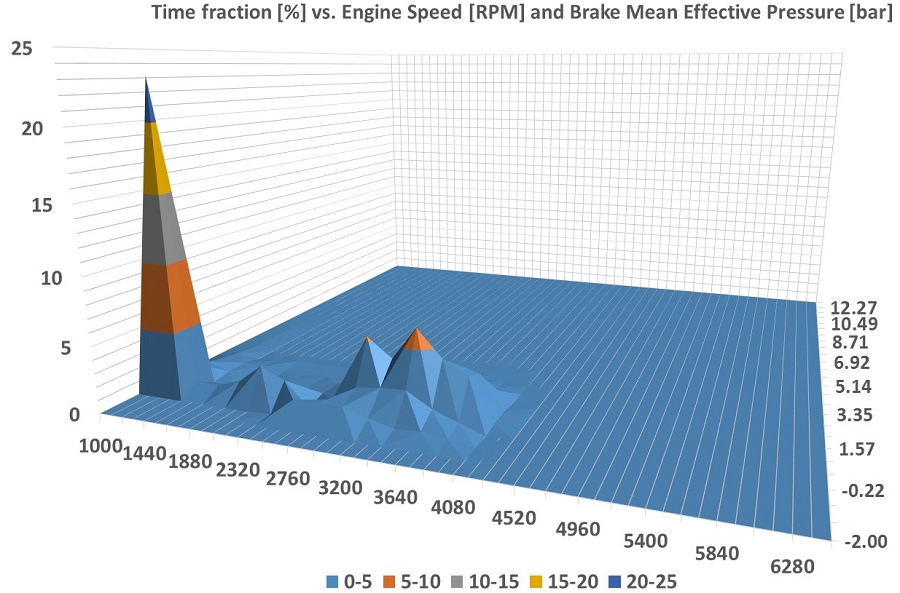Numerical Study of the Operation of Motorcycles Covering the Urban Dynamometer Driving Schedule
Keywords:
motorcycle emissions, chassis dynamometer testingAbstract
It is shown, for the most challenging case of a cruiser motorcycle of low weight-specific and displacement-specific power and torque, that the tuning for better top end performances is irrelevant for the operation over the driving schedule used for certification. During the certification test, the engine only operates in the low speeds and loads portion of the map. It is concluded that any statement about motorcycles’ pollution and fuel consumption should be only based on the measurement of their regulated emissions through proper chassis dynamometer tests, possibly redefining the driving schedule to better represent real driving conditions.References
“US EPA Light-Duty vehicles and trucks emission standards,” https://www.epa.gov/emission-standards-reference-guide/light-duty-vehicles-and-trucks-emission-standards, retrieved August 31, 2016.
“Transportpolicy.net US: Motorcycles: Emissions,” http://transportpolicy.net/index.php?title=US:_Motorcycles:_Emissions, retrieved August 31, 2016.
“US EPA Information for motorcycle owners,” https://www3.epa.gov/otaq/regs/roadbike/420f03045.pdf, retrieved August 31, 2016.
“US EPA Harley-Davidson clean air act settlement,” https://www.epa.gov/enforcement/harley-davidson-clean-air-act-settlement, retrieved August 31, 2016.
“Harley-Davidson Canada Screamin' Eagle® street performance tuner kit,” http://accessories.harley-davidson.ca/product/screamin-eaglesup/sup-street-performance-tuner-kit/41000008B, retrieved August 31, 2016.
“Pro super tuner, Harley Davidson super tuner wbt course,” http://prosupertuner.harley-davidson.com/training/ENU/index.html, retrieved August 31, 2016.
“Tune your harley motorcycle performance guide, Harley-Davidson closed loop ECM fuel map revealed,” http://tuneyourharley.com/biketech/content/harley-davidson-closed-loop-ecm-fuel-map-revealed, retrieved August 31, 2016.
B. Pereda-Ayo, and J. R. González-Velasco, “NOx storage and reduction for diesel engine exhaust after treatment,” Diesel Engine - Combustion, Emissions and Condition Monitoring, Dr. S. Bari ed., 2013.
“Yamaha YZF-R1 2016,” https://www.yamaha-motor.eu/uk/products/motorcycles/supersport/yzf-r1.aspx?view=featurestechspecs#2AdEJcOVkXKajV44.99, retrieved August 31, 2016.
“Yamaha FJR1300s 2016,” https://www.yamaha-motor.eu/uk/products/motorcycles/sport-touring/fjr1300a.aspx, retrieved August 31, 2016.
“Yamaha XVS1300 custom 2016,” https://www.yamaha-motor.eu/uk/products/motorcycles/cruiser/xvs1300cu.aspx?view=featurestechspecs#vb9pofy3Z43XY20Q.99, retrieved August 31, 2016.
B. Jacobson, “On vehicle driving cycle simulation,” Society of Automotive Engineering (SAE) Technical Paper 950031, 1995.
B. Bandaru, L. Rao, P. Babu, K. Varathan, J. Balaji, “Real road transient driving cycle simulations in engine testbed for fuel economy prediction,” Society of Automotive Engineering (SAE) Technical Paper 2014-01-2716, 2014.
N. Dembski, G. Rizzoni, A. Soliman, J. Fravert, K. Kelly, “Development of refuse vehicle driving and duty cycles,” Society of Automotive Engineering (SAE) Technical Paper 2005-01-1165, 2005.
M. Montazeri-Gh, H. Varasteh and M. Naghizadeh, “Driving cycle simulation for heady duty engine emission evaluation and testing,” Society of Au-tomotive Engineering (SAE) Technical Paper 2005-01-3796, 2005.
S. Trajkovic, P. Tunestal and B. Johansson, “Vehicle driving cycle simulation of a pneumatic hybrid bus based on experimental engine measurements,” Society of Automotive Engineering (SAE) Technical Paper 2010-01-0825, 2010.
J. Dabadie, P. Menegazzi, R. Trigui and B. Jeanneret, “A new tool for advanced vehicle simulations,” Society of Automotive Engineering (SAE) Technical Paper 2005-24-044, 2005.
A. Boretti, A. Osman and I. Aris, “Design of Rankine cycle systems to deliver fuel economy benefits over cold start driving cycles,” Society of Automotive Engineering (SAE) Technical Paper 2012-01-1713, 2012.
R. Allen and T. Rosenthal, “Meeting important
cuing requirements with modest, real-time, interactive driving simulations,” Society of Automotive Engineering (SAE) Technical Paper 940228, 1994.
L. D. Ragione and G. Meccariello, “The evaluation of a new kinematic emissions model on real and simulated driving cycles,” SAE Int. J. Fuels Lubr., vol. 3, no. 2, pp.521-531, 2010.
F. An, M. Barth and G. Scora, “Impacts of diverse driving cycles on electric and hybrid electric vehicle performance,” Society of Automotive Engineering (SAE) Technical Paper 972646, 1997.
Y. Jo, L. Bromberg and J. Heywood, “Octane re-quirement of a turbocharged spark ignition engine in various driving cycles,” Society of Automotive Engineering (SAE) Technical Paper 2016-01-0831, 2016.
H. Wang, X. Li, G. Zheng, Y. Fang, “Study of a hybrid refuse truck with city driving cycles,” Society of Automotive Engineering (SAE) Technical Paper 2014-01-1800, 2014.
C. Hong and C. Yen, “Driving cycle test simulation for passenger cars and motorcycles,” Society of Automotive Engineering (SAE) Technical Paper 970274, 1997.
A. Boretti, “Numerical modeling of a Jet Ignition Direct Injection (JIDI) LPG engine,” International Journal of Engineering and Technology Innovation, vol. 7, no.1, pp. 24-38, 2017.
A. Boretti, “Comparison of regenerative braking efficiencies of MY2012 and MY2013 Nissan Leaf,” International Journal of Engineering and Technology Innovation, vol. 6, no. 3, pp. 214-224, 2016.

Published
How to Cite
Issue
Section
License
Submission of a manuscript implies: that the work described has not been published before that it is not under consideration for publication elsewhere; that if and when the manuscript is accepted for publication. Authors can retain copyright in their articles with no restrictions. is accepted for publication. Authors can retain copyright of their article with no restrictions.
Since Jan. 01, 2019, AITI will publish new articles with Creative Commons Attribution Non-Commercial License, under The Creative Commons Attribution Non-Commercial 4.0 International (CC BY-NC 4.0) License.
The Creative Commons Attribution Non-Commercial (CC-BY-NC) License permits use, distribution and reproduction in any medium, provided the original work is properly cited and is not used for commercial purposes.



